Hop Press
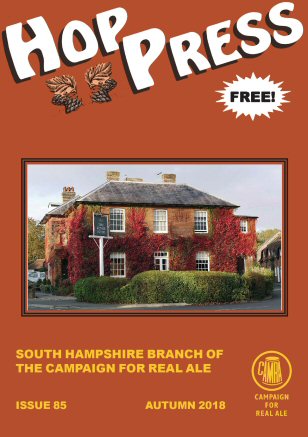
Issue 85 – Autumn 2018
View pdf version 2.3MB download
Go to Previous Hop Press Browse for another Hop Press
Go to Next Hop Press
Contents
- Editorial
- Branch Contacts
- Pub News
- Couldn’t Someone Just Bring Back…
- 50 Years of the Breathalyser
- Cask Report 2018-19
- The Greening of Beer
- Competition Crossword
- Good Beer Guide 2019
- Advertise in paper & pdf versions of Hop Press
EDITORIAL Hop Press
index
The first week of September saw the annual Great British Pubs Awards, organised by the Morning Advertiser, the licensed trade’s specialised newspaper, and sponsored by brewers John Smith. Overall, the national winner was in Highgate, north London, the Red Lion and Sun, but Southern Hampshire featured amongst the special category class winners.
The King’s Head at Hursley, near Winchester, was the winner in the ‘best managed pub of the year’ category. Our congratulations to them on their success.
Among the features that the judges mentioned were the economic conversion of part of the basement into a skittle alley for groups to rent, the ‘home-growing’ by the pub of many herbs and its discount strategy open to staff of the IBM site, also in Hursley village.
Our front cover for this edition shows the wonderfully colourful creeper-clad frontage of the King’s Head. [Thanks are due to Stephen Harvey for use of his photo].
“Climate change threatens traditional beer!” seems like a poster headline for a new Spielberg spectacular or an Al Gore polemic. It is though, the sober conclusion of a Belgian brewery and several beer enthusiasts particularly keen on their lambic beer style produced in a small area southwest of Brussels.
Lambic beer is a very unlikely survivor from a much earlier age. After the mash and the copper boil the wort to be fermented is run into open vessels but no yeast is added! Not an extraordinary oversight but, with all the brewery windows open, it is expected that a suitable wild yeast will drift in on an autumnal breeze and get things going, and, amazingly it always has, or at least until recently.
But, and it is a big ‘but,’ this is a very precariously balanced natural process – the yeasts themselves are only established in these areas because of the centuries of former brewing and they only inoculate well over a narrow range of air temperatures. The result is a brewing ‘season’ of somewhat less than half of the year and recently even this span has been noticeably reduced. A trend that could consign this unique brewing system to mere history.
Not quite equivalent to the melting of the polar caps but something one would think civilised nations could, and should, avert…
This year’s annual Great American Beer Festival has just drawn to a close in Denver, Colorado, in the foothills of the Rockies. This may not seem of much significance to readers of a parochial magazine about real (mostly British) ale in Hampshire but it really is – or, more accurately, will be in about a year’s time.
Since at least the start of the millennium, virtually all of the innovations, fashion trends and marketing ideas apparently originating from our brewers have really been transatlantic imports. A case in point: American IPA, sometimes East (or West) Coast IPA, New England IPA – often impossibly strong, impossible to see through and with as much resemblance to a Victorian empire-building soldier’s tipple as baseball has to cricket. Now, if the GABF is to be our guide, look out for the appearance of a first ‘Brut IPA’ brewed out to absurd dryness or how about a ‘Milkshake IPA’ which, apparently, is much as it sounds…
Some other rising trends showing in Denver included beers brewed with a medley of fruits and vegetables – cucumber, tomato, basil and then on to even more idiocy such as tree sap and pine needles!
They’ll surely appear somewhere here, you have been warned.
Ah, to have been a fly on the wall…
In the middle of September, Tim Martin, the founder and boss of the J D Wetherspoon empire, opened yet another of his many beer palaces. This one was a one-time cinema, the Palladium Electric in Midsomer Norton near Bath, a town that just happens to fall in the constituency of MP, one Jacob Rees-Mogg.
Given Mr Martin’s self-publicised and virulent pro-Brexit, anti-European views the like-minded politician was an obvious guest of honour for the opening day – though, clearly, without any celebratory champagne now that Tim has allegedly removed such vile potions from his inventory! Mr Rees-Mogg congratulated Tim and pledged to visit the pub again, so impending travellers to Somerset, beware.
After congratulating, at the start of this Editorial, one of our local pubs on winning a national award, we must not overlook our local breweries.
CAMRA’s annual Great British Beer Festival, in August at Olympia, and Great British Winter Ales Festival in February in Norwich are the venues each year for judging our National Beer Awards. This year one of our best-known local small breweries carried off one of the class prizes.
Although already mentioned in our spring issue, just as it had occurred, we record here our pleasure that the Red Cat Brewery, at Winnal in Winchester is the annual national award winner in the porter category for their lovely 4.5% Mr M’s Porter. Well done – well deserved!
International brewing giant Molson Coors are revamping their ubiquitous Doom Bar in some pubs as a new ‘super-chilled’ version. This will appear, via a conventional looking handpump, as an 8°C pint ‘aimed at the younger market.’
Sharps, the Cornish subsidiary of the north- American giant, say that the beer will be served from the same cask as the ‘normal’ 13° version which is very perplexing as the stated intention is to counter ‘the perceived notion that cask ale is warm and flat’ yet, as any publican knows the most obvious effect of over-cold beer is that it seems to have lost condition! The suspicion must be that some additional carbonation is involved prior to the super-chiller – nullifying any claim to being a real ale. If any reader spots this icy enigma please let us know: pubinfo@shantscamra.org.uk
There’s a mobile app for almost anything these days and the pub-goer is not neglected. For example, CAMRA has one that interfaces with our national pub/bar website WhatPub, enabling you to find the nearest pubs using up to 30 differing feature filters such as ‘dog-friendly,’ ‘garden’ or ‘live music.’
Now there is another very useful one from the Cask Marque group for when you are ensconced within your pub of choice – a pump clip recogniser, the CaskFinder.
Simply scan in the pumpclip and the app will return you the Cyclops tasting notes on the beer (the Cyclops Trust is essentially a database intended to cover every UK beer and maintained for free by Cask Marque. Any brewer can enter their beers onto the system with their own descriptions of taste, colour, aroma etc.)
If any brewers who do not have their beers on the database are reading this, can we urge you to sign up – CaskFinder already gets 60,000 queries each month, it’s totally free marketing!
Finally, a modest mystery, Best Bar None is a Government backed accreditation scheme with the avowed intention of:
‘Reducing alcohol related crime and antisocial behaviour. Increasing business, through the delivery of training, education and promotion of best practice, and, by creating a partnership between the local authority, police, the trade and the private sector to broaden the appeal of an area; especially it’s evening/night-time economy.’
It was piloted first in Manchester in 2003 and in the years since has now spread throughout the UK to some 75 major cities and towns, including Southampton. Annual awards are made in a number of classes, the winning pub, in Southampton, this year was the Dancing Man with the Rockstone as runner-up.
Yet, for a nationwide, formal, Government backed project why is it so little known? www.bbnuk.com
Want to contact us? Hop Press
index
The Southern Hampshire Branch of CAMRA has some seventeen hundred members and is run by an elected committee. Our print and pdf versions have a snapshot of their specific responsibilities. For a live version please see our 'Contacts' section - www.shantscamra.org.uk/contacts
Pub News Hop Press index
Otterbourne/Shedfield
We start with an apology. In the last edition we wrote that an application had been submitted to demolish and replace the entrance lobby and enlarge the toilet facilities at the Old Forge, Otterbourne. This was an error and in fact the application, which was subsequently permitted, was for an altogether different pub, the Old Forge Inn, at Shedfield! We apologise for this error and any embarrassment that it caused to the owners, management and staff of Otterbourne’s Old Forge.
Swanmore
The Hunters at Swanmore is under new ownership. It was purchased in April for £900,000 by pub company Heartstone Inns, which also runs the Walhampton Arms, near Lymington.
Lower Upham
We have previously reported that the Woodman at Lower Upham closed in December 2015. In April an application to use the site for housing was rejected. The plans were unpopular with many local residents and Winchester councillors.
One of the reasons for the rejection was that the plans included the demolition of the pub. In June a new application was submitted. It again included the site being used for four dwellings, but this time included the retention of the pub building following its conversion to a four-bedroom dwelling. This application was approved in July.
Meanwhile it is very sad to report that Joan Mort, who ran the pub with her partner Tony for close on half a century died in September after a short illness.
Twyford/Crawley
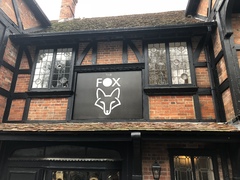
The Fox, Crawley
A few miles to the north-west, the Bugle at Twyford was announced to be for sale in July, with an asking price of £1.6m. As we mentioned in the last issue of Hop Press, the owner of the pub, Lenny Carr-Roberts, who saved the former Eldridge Pope pub in 2008 after it had been under threat of permanent closure, is to embark upon a new venture: reopening the Fox and Hounds at Crawley, north-west of Winchester.
This imposing, Tudor-style building was last open as a pub under Enterprise Inns at the end of 2015 and was bought by Mr Carr-Roberts last year (the Christie’s guide price was £650,000). Since then it has been undergoing extensive refurbishment with the reopening now eagerly expected early in the new year. [On-line version Stop Press: Now due to reopen, or has reopened, 29th October 2018, and name shortened to The Fox]
Bighton
A controversial planning application was submitted by the owner of the English Partridge in Bighton, which to many of our readers will be more familiar under its previous name, the Three Horseshoes. The application by owner Ashley Levett, was to build a house on part of the pub car park.
The application was rejected, despite claims from the owner that the granting of permission was the only way that the pub could be viable as a business. Half the households in the village had objected to the plans and local resident Jonathon Booth told the councillors on the planning committee that a group of villagers had submitted a bid of £500,000 to purchase the pub. Despite the pub being valued at £400,000, Mr Booth claimed that owner Mr Levett was looking for at least £700,000.
Winchester
Another pub garden is facing a change. The owners, Winchester College, decided that they wanted to use most of the garden of the Queen Inn for extra car parking for the college. Part of the pub’s car park will be used to extend what is left of the garden.
As the new garden area will be smaller than before, a charity auction was held in aid of the proposed Burrell House hospice, next to the Royal Hampshire County Hospital, to get rid of some of the surplus garden furniture. To temper the loss and add to the attractions, a planning application has been submitted for an external servery and gazebo.
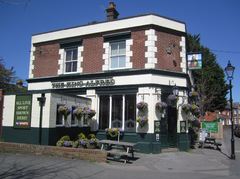
King Alfred, Winchester
Another city pub has undergone changes to its garden. A bar servery has been constructed at the King Alfred. Unfortunately, the licence to use this new facility arrived just too late to make use of it during the summer heatwave.
We have reported previously that music venues in Southampton had used crowd funding to raise money for repairs. The same method was used/engaged by the Railway in Winchester. The successful appeal raised more than £10,000 to fund improved access as required for rating, which is aimed at ‘improving deaf and disabled people’s access to live music.’ However, more funds are still required to guarantee its long-term future.
We mentioned in the last edition that Froggies Bar/La Place in Great Minster Street, closed in January. The premises are now home to Three Joes Sourdough Pizza.
Close by in the High Street, the Ivy Winchester Brasserie opened in May. While passing recently we noticed a diner with a bottle of Ivy craft lager. This beer is brewed for The Ivy by Harviestoun Brewery.
Finally, in Winchester, not exactly Pub News but certainly good news: make a diary note for next year:
Chandler’s Ford
South to Chandler’s Ford, in Bournemouth Road the application for a new 153-bedroom Village Hotel, including a bar, on a site next to Asda, has been granted. There is no news on an expected completion date.
Eastleigh
Following its successful opening as a pub, the Steam Town Brew Co is now serving beers brewed on the premises. The wide range of styles includes Barton Bitter (4.0% abv), Reefer Express (4.2%), Steam Stout (4.5%) and Stoke Pale (3.8%). Steam Town beers are also being sold in a small number of other local pubs. Although so recent a venture the pub has already earned a place in the new 2019 Good Beer Guide.
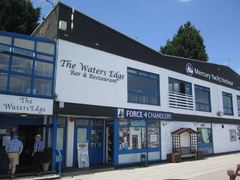
Waters Edge Bar and Restaurant, Hamble
Hamble
In July a new licence application was made for the Waters Edge Bar and Restaurant in the Mercury Yacht Harbour, Hamble. The bar, which was previously known as the Gaff Rigger, closed in March.
Hedge End
Further inland, the Shamblehurst Barn in Hedge End reopened in June after a six-figure refurbishment. A new sound system and more screens were added to the bar area and the range of cask ales on offer increased.
Horton Heath
We are still awaiting the reopening of the Lapstone in Horton Heath. In April it was announced that the opening had been delayed ‘to enable more work to be done on the pub.’ This is to include a coffee shop and Italian style restaurant. It was expected to reopen in the autumn.
Netley Abbey
As previously reported, the Netley Grange closed at the end of January after it was sold by owners Greene King. It has now reopened under the new name the Dancing Goose following an £80,000 refurbishment. It is being managed by Mike Andrews, with the support of his wife Mandi. The new name was chosen by their eight-year-old daughter, Summer.
Southampton: Woolston
Wildlife of a different kind has appeared at the Obelisk in Woolston. Licensees Natasha and Robin Wheeler have installed three young pigmy goats in the pub garden. The couple took over the pub in July and have also created a new play area for kids of the human form.
A previous application to convert the Ship Inn into three one-bedroomed flats was rejected. Now a new application has been submitted to create a convenience store on the ground floor with accommodation on the first floor.
Southampton: Bitterne
Previously we reported that an application to build 10 three-bedroomed homes on the site of the Big Cheese in Bitterne was rejected by city planners. Although the pub was listed as an Asset of Community Value no individual or group came forward to bid for the pub during the six-month period that was triggered by the application. The owners subsequently won permission for a change of use, though no takeaway could be built on the site. We await the result of an appeal against the original planning refusal.
Southampton: Swaythling
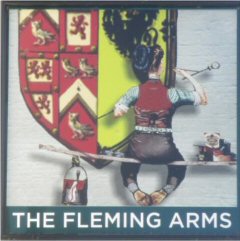
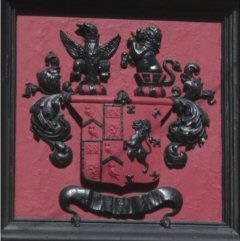
Swaythling: Fleming Arms Pub Sign… and the coat of arms itself
The Fleming Arms in Swaythling reopened last autumn following a six-figure refit. We have in the past bemoaned the plain pub signs that were sported by many Greene King pubs following refurbishments. That is definitely not the case at the Fleming Arms. The pub sign shows a painter decorating the Fleming coat of arms:
A quirky sign but slightly strange as the actual coat of arms on the front of the pub is painted rather more plainly:
Southampton: Highfield
Approval has been given for an extension to create a function room at the Brewhouse & Kitchen in Highfield. It involves moving the smoking shelter and paving area at the rear of the premises. The brewpub chain now has 21 outlets and announced its first profits for the period ending September 2017. It is still looking to open further outlets, with a new one due to open in Southsea in mid- November.
Southampton: St Denys
We are pleased to report that both the Dolphin and the South Western in St Denys are trading again following periods of closure. The Dolphin has been refurbished and features an outside bar and stage. One addition to the South Western’s support to the local community is the instillation of a defibrillator outside of the pub, thanks to the efforts of a group called the Friends of St Denys.
Southampton: Shirley
Verde has opened in Shirley Road on the corner with Lumsden Avenue. There is no real ale but keg beers have been on sale from local breweries such as Tap It and Vibrant Forest.
Southampton: Portswood
There have been a number of changes to the Portswood dinking scene in recent months. Sadly, both the Waggoners and the shortlived Tramstop closed in May.
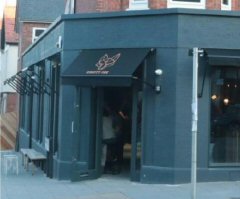
Crafty Fox, Portswood
There was better news however with the opening of the Crafty Fox. Cask beers are on offer in what was previously a Costa Coffee outlet. It is owned by Neil Davie and Colin O’Keeffe. As well as the beer, the venue opens at 8am in the morning for coffee and pastries.
Further along the road, Wild Lime Bar has new owners, Piers Kannangara and Thomas Dyer who run Heartbreakers in Hanover Buildings. Mr Kannangara also owns the Social Bar in the Bedford Place area.
Southampton: Polygon
Talking Heads in Portswood closed in 2015 but the name was revived when the owners took over the Maple Leaf Club in the Polygon. Sadly this new venue closed at the end of September but the management team will continue to provide music to the city at the 1865 in Brunswick Square.
Mayflower Village, most recently known as Encore, reopened at the end of September. It has large downstairs bar/function room (stairwell is new - on the left so the line of tables next to the windows have gone, with the bar entrance under the front door entrance). Upstairs, on our visit, three pumps were offering Adnam’s Broadside and Sharp’s Doom Bar and Atlantic.
Southampton: Bedford Place
The Bedford in Bedford place reopened in September following a £275,000 refurbishment. Amongst the new attractions are retro video games such as Pac-Man.
Southampton: Above Bar/London Road
Continuing on an entertainment theme, the managers of Stage Door announced in April that they were facing financial difficulties. The downstairs Rogues Café, which was sublet, closed in January.
This article contains news of many openings and closures. The closures often get more publicity, especially when they are traditional pubs with a lot of history. To mark such closures, artist Amy Scott-Pillow has created a pub sign artwork called ‘The Hope.’ She says it is based on the sign that used to hang outside the Ice House in the ‘50s. It was displayed in The Art House, Above Bar during September. Despite the many closures, there are also many openings in the city and a recent survey claimed that Southampton was in the top 10 areas outside of London in terms of pubs per square mile.
As predicted in the last edition, Common Rooms at 37-39 London Road opened in what was previously the home of Chalk Valley. With the emphasis on local products and beers on offer the likes of Siren and Eight Arch. However, we had barely time to add this into the Pub News before they announced their ‘closing down sale’ in early October!
Southampton: High Street
At the time of going to press a new outlet was due to open at 48 High Street. We were told to expect three handpumps in the Crammed Inn which is located between Steingarten and sports bar Liberty’s, which came under new management earlier this year.
At the bottom of the High Street we noted that the Platform Tavern was advertised for sale in June at £1,000,000 for the freehold.
Southampton: Oxford Street
In March, Dancing Man Brewery made a licence application for Havelock Chambers in premises that were at one time occupied by Casa Brazil. We believe that this plan was later abandoned, and we now read that an application has been submitted by Boozy Berry Ltd to open Nook Bar and Kitchen at the same venue, 20-22 Havelock Chambers, Queens Terrace, on the corner of Latimer Street.
We note that work has started at the proposed Tap It pub in Oxford Street but there is no news of an opening date as yet. Across the road we also see that the White Star is now part of the Fullers group.
Romsey
The ex-Gales, now Fullers owned, Old House at Home in Love Lane is listed on the Christie’s website as available for lease at a suggested £75K/annum.
Another Fullers outlet, the Cromwell Arms continues to submit planning applications. In May the requests were for retrospective permission for various works in the garden plus a separate request for external lighting. Both requests were subsequently withdrawn.
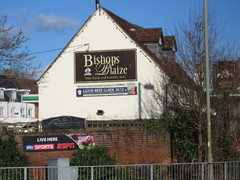
Bishops Blaize, Romsey
There has been correspondence in the Romsey Advertiser over the name of the Bishops Blaize in Winchester Road. It surrounds the appropriateness of the “s” at the end of Bishop in the pub’s name. CAMRA’s Hampshire pub guide published in 1986 omits the s. The book So drunk he must have been to Romsey features a photograph of the pub with no s in the name painted on the wall. Looking through our records, advertisements for the pub in the 1990s also omitted the s while newspaper coverage is inconsistent in its use, with an apostrophe often used. Into the 2000s and planning applications from 2003 and 2005 include the s without an apostrophe, as does the name currently on the outside of the pub. Maybe a reader versed in ecclesiastical history can elucidate?
We were sad to hear of the death of former Tudor Rose landlady Marty Blincoe earlier this year. She was at the pub between 1972 and 1991 and played a full part in town life including helping to found the Romsey Society and the Beggars’ Fair.
On the edge of town, the Dukes Head at Greatbridge, which has suffered from numerous closures and reopenings in recent years, closed again at the beginning of the year.
Braishfield
An application to build a single storey side extension to the Wheatsheaf, Braishfield was subsequently withdrawn.
Elsewhere in the village, the Dog and Crook now offers B&B facilities with six en-suite rooms. New manager Chris May will look after the business at the pub alongside longstanding owners Alan and Miriam Arthur.
East Tytherley
The Star in East Tytherley underwent a £60,000 refurbishment in the spring. There are new rooms outside the pub and a new skittle alley. It also offers three bed and breakfast rooms.
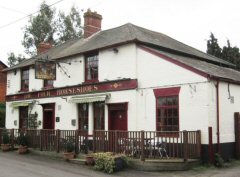
Four Horseshoes, Nursling
Nursling
A possible pub resurrection in the Test valley? A planning application has been agreed for a rear extension to the Four Horseshoes in Nursling plus the erection of five houses in part of the garden. The housing will help towards the £½m cost of the work needed to the pub which has now been closed for almost a year.
Ampfield
We are pleased to report that after the fire at the Potters Heron hotel in March, which the fire service think was started by a spark in a chimney, the pub was quickly trading again. Repairs have been made to the damaged roof, which is being re-thatched as we write.
Lymington (Middenham)
The Potters Heron once attracted national media coverage as it was the venue chosen to unveil Southampton’s signing of Kevin Keegan. The town of Lymington became familiar to TV viewers earlier this year as it was the setting for the fictional town of Middenham in the ITV drama Unforgotten.
Many scenes were shot at the Angel and Blue Pig and the Ship Inn also featured. Unlike the town, the pubs retained their names in the programmes.
The licensees of the Borough Arms, Carl and Debbie Millward, offered locals the opportunity to comment on their plans to make changes to the premises. Many customers took up the offer and their views were taken into account when an application was submitted for a single storey extension into part of the courtyard that would double the size of the kitchen and increase the dining area.
Open again following a fire that closed it not long after the original opening is the Lobster and Burger Bar.
Downton
Debbie and Duane Lewis, who already run the New Forest Inn at Emery Down, the Trusty Servant at Minstead, the Mortimer Arms at Ower and the Royal Oak at Hilltop have added a fifth pub to the group. It is another Royal Oak, this one at Downton, which underwent a refurbishment earlier in the year.
Bransgore
The Three Tuns, although retaining the same management, is now technically a ‘free house,’ able to order beers from any brewer. They intend fitting more handpumps and serving beers from: ‘as many brewers as possible.’ More power to their elbows!
Lyndhurst
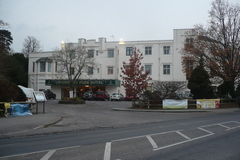
Lyndhurst Park Hotel
Owners Pegasus Life lodged documents with the National Park planning authority to determine whether it was possible to demolish a single storey rear extension at the Lyndhurst Park Hotel, arguing that it should be allowed due to the small scale of the work that should not require planning permission. The work was given the go ahead and there was certainly significant work on new fencing taking place there when we recently passed the hotel, which closed in 2014.
The long-term future of the site should become clearer after the public enquiry that will be held in January, where the owners will try to get the refusal of their plans for 75 retirement flats and 15 ‘affordable homes’ overturned.
Bramshaw/Brook
The 28 bed Bell Inn, Brook has been put up for sale by its owner, Robert Crosthwaite Eyre. The two adjacent golf courses are also up for sale although they can be purchased separately from the pub if you can’t afford the £4.5m for the full package.
Sway
We mentioned in the last edition that a revised planning application to build two homes on the site of the Silver Hind in Sway had been submitted. The proposal was subsequently refused by the National Park planners.
Eling
The Anchor Inn, Eling has a new look and new licensee. Kirsty Williams, who also looks after the Elephant and Castle in Totton, oversaw the internal and external refurbishment while the pub was closed for the work to take place.
Ashlett Creek
Rumours circulate that the Jolly Sailor, haunt of many a thirsty yachtsman, will shortly be on the rental market but at the time of writing there is no confirmation.
Woodlands
Earlier this year the Gamekeeper at Woodlands, near Ashurst underwent a £200,000 refurbishment. It was overseen by licensees Alan and Simeone Taylor, who already run the Miller’s Pond in Sholing. The changes included new doors and glazing.
New Milton
The Central Bar in Station Road, New Milton has won permission for a smoking terrace. Only 10 customers will be able to use the first floor facility at any time.
Hinton

East Close Hotel, Hinton
The East Close Hotel and Conqueror Inn was due to close in October. It had previously been suggested that owner Meyrick Estate, who re-acquired the property less than two years ago, were going to refurbish the premises.
Hamptworth
An opportunity to run a lovely, all gravity real ale pub? Just over our border with CAMRA’s Salisbury branch, but well-known to many in this area, the Cuckoo is said to be available to lease at some £50K annual rent.
Ringwood
Phil Hoyle and Sarah Williams have taken over the London Tavern in Poulner. The couple have been regulars at the pub for a number of years and Phil has previous experience in the licensed trade.
Not far away, permission has been granted for a detached store at the White Hart Inn, Ringwood.
Plans for a micro-pub in Ringwood were supported by town councillors. The premises, in a former estate agents at 10 Christchurch Road, have been granted a licence as the Cock and Bottle. The application was made by the Cocky Pub Company.
Staying in Christchurch Road, with the emergence of so many new small breweries and micro pubs it is sometimes easy to forget that at one time Ringwood was once part of the new brewery vanguard looking to challenge the more established companies. In the summer, Ringwood’s head brewer Jeff Drew retired after some 40 years working in the industry. He moved to Ringwood in 2002 and became head brewer a year later. We wish Jeff a long and happy retirement. He has been replaced by Maurice Walton, who has been with the brewery since 2004.
If you have any news about pub openings, change of landlords, closures, or other interesting news, let us know at pubinfo@shantscamra.org.uk
Couldn’t Someone Just Bring Back… Hop Press index
A long lifetime of pub-going has covered a vast sea of changes in the nation’s culture and mores. Many common-place things have vanished, though only a few with tinges of regret. Here are a few that spring to mind:
The Tavern Car. A pub on rails! Perhaps to cheer us up after the war and its ensuing austerity.
Southern Railway’s chief designer, New Zealander Oliver Bulleid, was so impressed by British pubs that he made one to go on the Southern’s system. Based, allegedly, on the Chequers at Pulborough, they were as publike as he could manage, down to the fake half-timbering, painted-on brickwork and each with its inviting nameboard – the White Horse, Green Man etc.
Attached to only the more prestigious services, they served the full spectrum of drinks of a pub of the era including draught beer. Here though, memory is a bit hazy, what beer it was and how dispensed I cannot remember. But, they made a trip up to London on the Royal Wessex (something else that could be resurrected?) very pleasant.
Crabbers’ Nips. Plus all the other strong beers in ‘nip’ bottles. Up until perhaps the eighties many regional brewers had their own variety of strong (6+% abv) ale in small nip – six or so ounces – bottles which punters would insert, from time to time, into their pints to perk up the drinking experience!
Crabbers’ Nips were the speciality of Weymouth’s (and Redruth’s) sadly missed Devenish breweries, a lovely tawny barley wine of some 7-8% (brewers were very reluctant to talk about alcohol then). There were many others – even the mighty Watney conglomerate produced a palatable one – their dark Stingo. The most ubiquitous and perhaps longest lasting was Whitbread’s Gold Label, brewed under licence at many other breweries, and still lingering as a canned supermarket version.
Mixed beers (with odd names). Recently, at a pub with a wide choice of cask ales, I remarked that a porter on offer and one of the mid-gravity bitters would probably make a lovely ‘black and tan.’ To the bar staff the idea of mixing draught beers was viewed as vaguely absurd and the use of a curious name as even more so. They had no recollection of ever being asked to mix beers (other than with lemonade for shandy or tops).
A note to purists: the strictly proper Black and Tan is, I believe, Draught Guinness with Draught Bass.
Yet, as a student of the fifties, a pub could not be found where the order for a ‘boilermaker’ (bottle of brown ale with a half of mild) or simply for a ‘mild and bitter’ would not be completely comprehended.
Sunday crisps and peanuts. In the good old days before pubs were open more hours than Nature ever intended, Sunday lunchtime was part of a sacred ritual filling the meagre two hours from twelve to two. All friends could be guaranteed to be present and correct in that narrow window and even the humblest boozer would mark the special nature of the time by providing a free bar-top buffet – bowls of crisps and peanuts (quite possibly the out of date stock, but so what!), some bits of cheese and maybe sausage segments of uncertain vintage.
The nostalgia is not for the lost nourishment but for the loss of the ritual.
50 Years of the Breathalyser Hop Press index
July saw the seventieth anniversary of the founding of the NHS. This was seen by most of the population as a reason to celebrate. But, what many people may not realise is that at the time of its founding there was opposition from many quarters. Indeed, many of the institutions and laws that today are accepted as the norm and are supported by all the main political parties were similarly steeped in controversy at the time of their introduction. The minimum wage is a more recent typical example. So to this one:
Last year saw the fiftieth anniversary of the introduction of one, the breathalyser test. The Road Safety Act of 1967 introduced the first maximum legal blood alcohol (drink driving) limit in the UK. The breathalyser was introduced so that a measure could be taken at the roadside. The new law came into effect on 7 October 1967.
Below we look at how it was reported at the time in local newspapers. The extracts are taken from the Lymington Times ‘From our files’ feature and from the Daily Echo’s ‘Looking Back Through Time’ column.
But what was the ‘safe’ amount to drink before driving? In the month of the introduction of the new law the Echo reported that, “A Southampton doctor warned that four single whiskies or two pints of beer should be the absolute maximum if people wanted to get behind the wheel as a new law came into force. The legislation set the limit of 80 milligrams of alcohol in 100 millilitres of blood. Police would not be carrying out random checks, but anyone caught over the limit faced an unlimited fine or up to two years in prison.”
Prior to the introduction of the 1967 Act it was commonplace for motorists charged with being ‘drunk in charge’ to be acquitted even if a blood alcohol test had been administered and shown levels of 150 milligrams or even more!
In December 1967 the Lymington Times reported that: “Because of medical advice that he must reduce his commitments drastically, Col Sir Oliver Crosthwaite-Eyre (54), Conservative MP for the New Forest, will not be standing at the next general election.
In a separate report, addressing a meeting of the New Forest Licensed Victuallers, Sir Oliver spoke against the breathalyser test, stating: “If I were stopped I would protest at every stage since I feel the present law is a complete violation of individual liberty.”
He added: “To a great many people in this day and age their driving licence is a matter of life and death. Of course, we must do something to see that the drunken driver is properly penalised, but if a person lost his licence for one offence, it would affect his whole life and his family’s career. It is very unfair.”
Someone who exceeded the limit featured in a report in the Lymington Times in December 1967: “The first person to be prosecuted at Lymington Magistrates for driving when the proportion of alcohol exceeded the limit of 80 milligrams per 100 millilitres was fined £20 and disqualified from driving for 18 months.”
The 56-year-old from Southampton was given three breathalyser tests and was stated to have told a police officer: “I am quite sober, I have only had three Guinnesses. I can drive perfectly well. It’s not me you want to worry about – it’s the people who can’t stand up.”
The driver, a former D-Day paratrooper who was employed as a toolmaker with a Lymington firm, had previous convictions for driving without due care and attention and for being in charge of a vehicle when under the influence of drink.
A view on the impact of the introduction of the breathalyser featured in a post-Christmas 1967 Echo report: “The threat of the breathalyser and a mini flu epidemic made it a stay-at-home Christmas for thousands across the south. Police and motoring organisations reported holiday traffic in Hampshire and the Isle of Wight far quieter than previous years. Accidents were down, and new drink-drive laws made drivers leave their cars in the garage.”
Members of the licensed trade also had a view of the impact of the new law, as seen in this report in the Lymington Times from March 1968: “Although some of the breweries claimed there had only been a two per cent drop-off in trade due to the breathalyser, it was something like five per cent in some houses, said Mr J. J. McCarthy, president of the Lymington Licensed Victuallers’ Association speaking at their annual banquet and ball at the Camden House Hotel, Milford.”
Since the introduction of the breathalyser there have been a number of other changes to drink driving laws and there may well be other changes in the future. The most likely of these is the introduction of lower alcohol limits in England so that they line up with the lower 50 milligram limit introduced in Scotland in 2014, following it becoming the standard over most mainland European countries. Since the introduction of the 1967 Act road deaths have fallen by three-quarters despite a doubling of the number of cars on the road.
The Cask Report 2018-2019 Hop Press index
For the twelfth year running, Cask Marque, the cask beer quality monitoring group, have published their annual report on the state of cask beer – real ale – in the British pub estate.
This comprehensive, 44-page report is available as a downloadable pdf from: https://cask-marque.co.uk/cask-report-2018-19 It is essential reading for all licensees who have any part of their trade in cask ale (and perhaps even more so for any who still do not!).
This year’s report carries the sub-title of Cask Reconsidered to reflect some rather disturbing and unexpected findings this year. Chief amongst these is a fall, although an oddly disjointed one, in the ratio of cask ales to the total beer market. After some 3% decrease during the spring and summer of 2016 there has been another similar change this year but after virtually no change in the intervening year, 2017. Within the cask ale spectrum, golden styles pushed ahead somewhat, and it was the amber/mid-brown, traditionally British (seen as old-fashioned?) bitters that declined most.
Another, possibly significant, finding is that the more well-known brands tend to outperform the market as a whole. This may well reflect another very marked feature of current times – the vast increase in numbers of cask ale breweries and hence the ales themselves. It is possible that the degree of choice offered in some pubs is too daunting for the less experienced cask drinkers?
Despite this modest fall in the cask to total beer sales ratio some 85% of all licensees see cask beer as more than, or at least as, important as it was when asked four years ago. But with upwards of perhaps 8,000 cask beers being brewed in the UK at over 1750 breweries at present it is clearly vital that these same licensees’ roles are as much educationists as shopkeepers.
To quote the report: ‘Cask ale, to people who do not drink it, remains a mystery.’ Every effort is needed to strip away this mystery and to do it without the customers feeling they are being any burden. Offering tasting samples is a must, with the bar staff initiating the offer. Lots of clear information on chalkboards or perhaps, for the techies, on an easy to reach web-site could also help to dispel the innate feeling that to appreciate cask ale needs some sort of tribal initiation…
Craft ale is seen as a major factor of the drop in cask sales but not as just a competing product but more as a successor with the damaging impression that cask ale has become obsolete, the drink only of old men. But this is in a nostalgic rather than antagonistic sense, especially amongst the under thirties who would, in many cases, be as likely to sport a pocket watch and chain as order a pint of cask from the micro-brewery a few streets away.
But cask beer should not attack craft, rather it should emphasise their generic relationship with both styles being equally the true, tasty replacement of the (Watney) red revolution.
The vexed question of serving temperature is addressed. A large majority of cask drinkers say they would prefer their beer served cooler (many results are from a study by Molson Coors – see this edition’s Editorial section on their current trials). However, it is not clear if this truly means ‘cooler than the 11-13°C recommended range’ or ‘cooler than the 14+°C commonly found in the pub.’
Beer quality comes under examination – the vast majority of licensees surveyed were sure that their cask ales never exceeded three days per cask in service but figures from pubs with in-line flow monitoring of beer sales suggest that, on average, it takes more like a week to pull up each firkin. This leads on, of course, to how the customer and the publican are able to resolve issues over the pint that is not up to scratch.
With the drinkers, by far the biggest issue is that only about one in three poor pints are ever complained of in the first place. Always because of reluctance to embark upon a technical debate on grounds that are felt to be uncertain. Most would just store the experience resolving not to order cask there again or even not visit again.
From the bar staff’s side, unquestionably the most infuriating response is the ‘…It’s real ale, it’s meant to be like that…’ still heard all too often, but equally disturbing is to see the beer continue to be sold to other customers.
Several pages of the report deal statistically with pub types – managed, tenanted and free and with the number and range of cask beers on offer. Half of the pubs in the survey had five or more with a quarter at seven or more. Analysing the pubs by levels of weekly turnover show some quite disturbing results; can a pub operating at less than £4,000/week justify six or more cask lines? One in five say yes.
In general, the report concludes that there has probably been some degree of overshoot in the explosive growth of cask ale service. Most outlets with more than five or six product lines might benefit from a careful cost/benefit study of the optimum number for the level of trade.
Several sections offer diversions into other study areas. One is a look at the remarkable resurrection of the vinyl record industry and how this compares very closely to the rebirth of cask beer. A second, two page spread, provides an overview of the volcanic changes in the gin market in the past decade.
A particular point is the way that this sudden growth of interest in the spirit also led to a totally unforeseen growth in mixer choice. Even glassware styles expanded – a trend also reflected of course in both craft and cask beer markets.
The report would not be complete without some analysis of the price structure in the nation’s pubs. The finding that cask is priced consistently 30-40p/pint below mainstream lagers and a huge £1+/pint below craft ales will not surprise many readers. Yet, what still seems a mystery and is very strange, is that many cask drinkers don’t realise it is the cheapest! There are certainly good business reasons for an element of price restructuring that recognises the greater complexity of keeping and serving a perfect pint of cask ale.
Paul Nunney, one-time sales director at Adnams Brewery in Suffolk and founder, and subsequent leader, of Cask Marque since its inception in 1998 rounds off with a summary of the £1.6 billion market that is cask ale. The very nature of the pub is changing fast, together with its clientele. It will never revert to the smoke-filled, all male refuge of the time when cask ale was the only option in town. Cask must now earn its place.
The Greening of Beer Hop Press index
You may be reading this in a Hampshire pub where one or more of the handpump clips has a
‘topper’ with the typographical nightmare of:

Possibly then
puzzled, you wonder: ‘what does that mean?’
The scheme, now nationwide, came about, in a sense, accidentally. In 2007 the Nottingham branch of CAMRA were shocked when the city’s major brewer, Hardy and Hanson was suddenly absorbed into the giant Greene King octopus. The buzzword was coined as part of their campaigning against the takeover and loss of some local heritage.
However, such was the ethos of the times that it was quickly adopted, and adapted, by CAMRA’s prominent green element. Food and drink transport (including the initial raw materials) account for some 25% of all road goods traffic and national – even more so international – brewers are endlessly proliferating their beer miles.
So, the LocAle scheme metamorphosed into a ‘support local produce from your neighbourhood brewer’ campaigning tool which has now been adopted by over 125 CAMRA branches throughout England, Scotland and Wales.
To qualify, firstly, a pub must be willing to be listed and to take part. Secondly, a pub must be nominated by any CAMRA member who has known it well enough to say that its real ales are well-kept and that at least one is always from a local brewery. It does not have to be continuously the same beer or even brewery, but it must be as an intended permanent feature, not an occasional guest ale.
A slight geographical variable, from branch to branch, is ‘what counts as local?’ – a different concept to a city-dweller or, say, a highlander from Scotland. Branches have used differing measures appropriate to their geography. Here, in southern Hampshire we have taken 25 miles of crow-flight as our gauge. Real ales from regional and national breweries are acceptable if their real journeys qualify; thus, a Ringwood beer will be OK in much of our area, but other Marston group beers would not.
The LocAle concept is fully in line with the Sustainable Communities Act, which, coincidentally, was also enacted in 2007 and which CAMRA strongly supports.
How can I find LocAle pubs in my neighbourhood? The national CAMRA website, ‘WhatPub’ has a filter that will indicate them for any area of the country. In our own southern Hampshire branch we currently list some 67 outlets (56 pubs plus a few clubs – more would be welcome – and a number of ‘brewery taps’) These are all listed on the public pages of our website: www.shantscamra.org.uk/campaigns/locale/
The same area of the web site also links to a Google map that shows our branch area with a flag for every brewery that comes within the 25 mile criterion of any part of it – an astonishing number that exceeds seventy, and continues growing!
Competition Crossword Hop Press index
(download printable pdf version here)

Please note that clue 7 down has been corrected below. The pdf versions download before midday 24/11/2018 still have a slight misprint.
|
|
||||||||||||||||||||||||||||||||||||||||||||||||||||||||||||||||||||
Prizes to the first two correct entries drawn. Closing date: 31st December 2018.
Send to:
The Editor, Hop Press, 1 Surbiton Road, Eastleigh, Hants. SO50 4HY
Issue 84 (Spring 2018) Solution & Winners
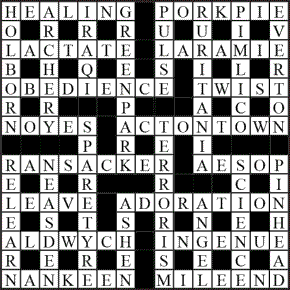
Another good entry for this edition, 29, although 4 unfortunately had single errors, three of which, in 1 across, were the same. Entering HEARING in place of HEALING, ignoring the clue’s instruction to ‘change sides.’
Winners, drawn from the hat, for this edition:
Jocelyn Britcher, Southampton
Keith Jones, Dibden Purlieu
| The other twenty-three correct solvers were: | |
|---|---|
| Ron Brading | Lew Cohen |
| Nigel Cook | Paul Doughty |
| Martin Gardner | J E Green |
| C Grierson | Stephen Harvey |
| Norman Hurl | R S Milligan |
| Gary Morse | Neil Mort |
| Mike Nichols | Tim Parkinson |
| Nigel Parsons | Jeff Phillips |
| Rebecca Pink | Ron Poole |
| Martin Sirl | Trevor Smith |
| Howard Sprenger | Dave Walbridge |
| John Wiseman | |
Good Beer Guide Hop Press index
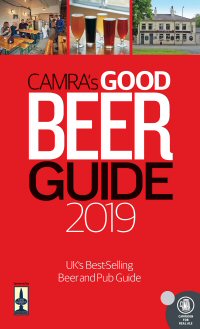
Early September saw the publication for the 46th year of our flagship publication, the thousand page plus Good Beer Guide for 2019.
Listing not just 4500 of the nation’s finest beer pubs but also, uniquely, with some 290 pages detailing over 1750 breweries. Now available in the bookshops or by mail from: https://shop.camra.org.uk.
The guide is also available in the form of a mobile app at: gbgapp.camra.org.uk and as POI, (points of interest) files for several formats of sat-nav at: www.camra. org.uk/gbg-sat-nav.
Don’t leave home without it!
Advertise in the paper & pdf versions of Hop Press Hop Press index
3,600 copies of Hop Press are distributed to pubs around Southern Hampshire Branch area.
If you would like to advertise in this publication please ring Neil Richards MBE on 01536 358670 or email: n.richards@btinternet.com
Advertising Rates are:
- ¼ Page: £70 mono; £80 colour
- ½ Page: £130 mono; £145 colour
- Full Page: £230 mono; £260 colour
- Inside Covers page: £280 colour
- Outside Back: £300 colour
Hop Press issue number 85 – Autumn 2018
Editor: Pat O'Neill
1 Surbiton Road
Eastleigh
Hants.
SO50 4HY
023 8064 2246
hop-press@shantscamra.org.uk
© CAMRA Ltd. 2018


|
© 2026 CAMRA Ltd. All rights reserved. Campaign for Real Ale, Southern Hampshire Branch Pages supplied by & updated by the Webmaster: Pete Horn [View Site Disclaimer, Personal Data Handing, and Cookie information] [Site History] |